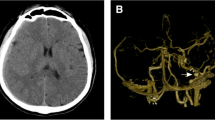Abstract
The authors report the case of a 5-year-old female with right-sided hemiparesis and aphasia secondary to moyamoya disease, who had previously undergone staged bilateral encephaloduroarteriosynangiosis procedures. A subsequent ground-level fall caused an acute traumatic subdural hematoma with mass effect and neurological decline. She underwent emergency hematoma evacuation and decompressive craniectomy, which required interruption of the superficial temporal artery that had been used for indirect bypass, followed later by autologous cranioplasty. There were no acute or long-term ischemic events related to the occurrence or treatment of the traumatic hematoma. Follow-up angiography revealed extensive spontaneous vascular collateralization in the field of the decompressive craniectomy and cranioplasty. The patient returned to her pre-injury neurological baseline.

Similar content being viewed by others
References
Adelson PD, Scott RM (1995) Pial synangiosis for moyamoya syndrome in children. Pediatr Neurosurg 23(1):26–33
Kim SK, Cho BK, Phi JH, Lee JY, Chae JH, Kim KJ, Hwang YS, Kim IO, Lee DS, Lee J, Wang KC (2010) Pediatric moyamoya disease: an analysis of 410 consecutive cases. Ann Neurol 68(1):92–101. doi:10.1002/ana.21981
Piedra MP, Thompson EM, Selden NR, Ragel BT, Guillaume DJ (2012) Optimal timing of autologous cranioplasty after decompressive craniectomy in children. J Neurosurg Pediatr 10(4):268–272. doi:10.3171/2012.6.PEDS1268
Reis CV, Safavi-Abbasi S, Zabramski JM, Gusmao SN, Spetzler RF, Preul MC (2006) The history of neurosurgical procedures for moyamoya disease. Neurosurg Focus 20(6):E7
Scott RM, Smith ER (2009) Moyamoya disease and moyamoya syndrome. N Engl J Med 360(12):1226–1237. doi:10.1056/NEJMra0804622
Scott RM, Smith JL, Robertson RL, Madsen JR, Soriano SG, Rockoff MA (2004) Long-term outcome in children with moyamoya syndrome after cranial revascularization by pial synangiosis. J Neurosurg 100(2 Suppl Pediatrics):142–149. doi:10.3171/ped.2004.100.2.0142
Sonobe M, Takahashi S, Kubota Y, Shirane R (1982) Chronic subdural hematoma developing after EMS for moyamoya disease. No Shinkei Geka 10(8):857–859
Takeuchi S, Ichikawa A, Koike T, Tanaka R, Arai H (1992) Acute subdural hematoma in young patient with moyamoya disease—case report. Neurol Med Chir (Tokyo) 32(2):80–83
Acknowledgments
The authors thank Shirley McCartney, Ph.D., for the editorial assistance and Andy Rekito for the figure preparation.
Conflict of interest
The authors report no conflict of interest concerning the materials or methods used in this study or the findings specified in this paper.
Author information
Authors and Affiliations
Corresponding author
Rights and permissions
About this article
Cite this article
Curry, M., Whitney, N., Roundy, N. et al. A case of acute traumatic subdural hematoma in a child with previous bilateral encephaloduroarteriosynangiosis. Childs Nerv Syst 30, 699–702 (2014). https://doi.org/10.1007/s00381-013-2285-3
Received:
Accepted:
Published:
Issue Date:
DOI: https://doi.org/10.1007/s00381-013-2285-3




